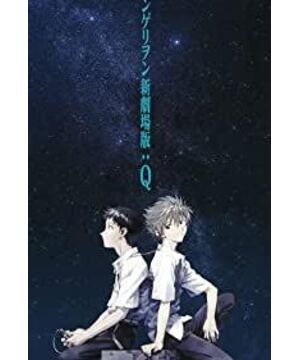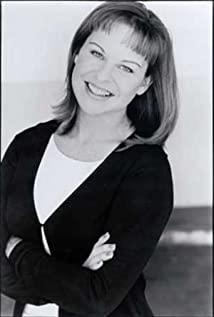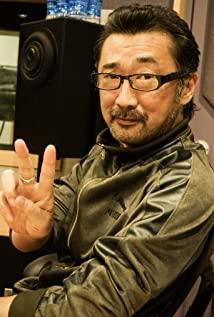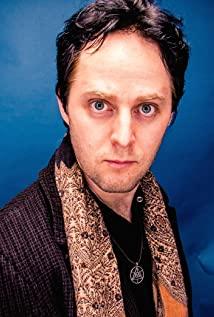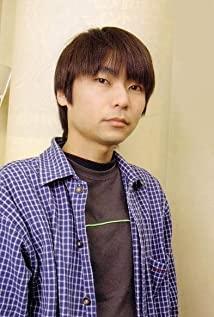Anno Hideaki seems to have no intention of telling the viewer what happened in the central dogma—the center of the third shock explosion. The only thing that can be confirmed in "Q" is that the same splitting, bleeding marks appear on the surface of the moon in the old ending. This should have happened at the same time as the transformation of Lilith in the central dogma into Ayanami. There is a meaningful scene near the end of "Broken". The first machine enters a state close to God, and Lilith in the central dogma is safe and sound. Does this mean that After awakening in the story line of "Q", the first machine went to the central area? So that led to the tragic remains seen in "Q"?
Kaoru was clearly present at the time, on the way down to the dogma, he explained the sealed state where no one had entered for 14 years, after landing, unlike Shinji's shock, he knew very well that it was Lilith's corpse, and MARK.06 is the result of being abandoned after being changed into a self-disciplined type. However, he wondered why the two different guns had turned into two identical Longinus guns.
Why must two souls draw guns? Because it was sealed by two souls, Lilith became Ayanami. Anyone who has seen the ending of the old version knows that this is the result of Ayanami's return to the main body. The change of MARK.06 to self-discipline means that there is no driver, because MARK.06 itself is It was transformed from a white giant that looks like Adam. Ikari Gendo kept a hand. He used a Longinus gun in advance to disguise it as a Cassius gun, or he secretly replaced one of them in some way in fourteen years. A scene from Q.
At the end of "Broken", Ayanami incarnates a huge blood body (representing Lilith's soul) and merges with the first machine. This is the awakening of Lilith as the trigger, in the shape of an air flow, with a halo on the top of his head. This time, Kaoru was deceived, and the No. 13 unit, which switched to single-player mode, pulled out two guns by only Shinji. The twelfth apostle, who originated from Adam with Kaoru, did not die. Unit 13 was wrapped up, Kaoru's identity was immediately revealed, he became the thirteenth apostle (a superfluous apostle), and Unit 13 swallowed the fruit of Lilith's corpse, triggering the fourth shock, which was based on Adam was awakened by the trigger, with a pure white body and a halo behind his back, which Kaoru did not expect.
Kaoru is a teenager who represents the seele side. He is the first apostle and one of Adams (note that it is plural). Seele and NERV used to be two forces that compete with each other, and the resources they occupy are also different. However, in "Q" , they seem to have reached a certain consensus, with the same purpose - to kill the gods.
Kaoru was desperate. He wanted to help Shinji, but was used by Ikari Gendo to lure Shinji to successfully advance the fourth attack. As represented by the number 13, he became Judas, a "traitor" who betrayed the Son. He finally said to Shinji, "I'm sorry, this is not the happiness you want." "Don't show that expression, we will see you again."
So at the end of "Broken" we will see that Kaoru uses the Cassius gun. Terminated the awakening of the first machine, and said: "This time I must give you happiness alone." Does
this mean that in the next part, the story will start again along the broken plot? However I don't understand, the subtitle of the third volume, YOU CAN (NOT) REDO, you can't do it all over again. However, the title of the fourth part uses a symbol that can be regarded as both a cycle and a termination. "Shin·エヴァンゲリオン Theatrical Edition: |┃" will get two different interpretations if the colon is counted or ignored. The titles of the three volumes are the same and are optional.
This question was finally revealed by a Japanese netizen.
Sequence: YOU ARE (NOT) ALONE
Break: YOU CAN (NOT) ADVANCE
Q: YOU CAN (NOT) REDO
"There are 2 completely opposite stories with or without NOT version in Preface, Broken, and Q. In the parallel world, they are separated by HappyEnd and BadEnd, and they are interactively filmed and released from each of them. The sequence plays the version with NOT. , Po is playing the version without NOT, Q is playing the version with NOT, but it may be the version without NOT. And the version without the movie will be completed in the audience's mind in the next preview.
" Japanese netizens are a little wrong. "Broken" is actually a version with NOT. In "Broken", Shinji, who has been timid, finally took a brave step. He desperately rescued Ayanami and hugged her. Thank you She showed her intentions, but the world was about to be destroyed because of it. In fact, the content of the two "Broken" is exactly the same, the only difference is whether Kaoru comes to the earth in the end, if Kaoru fails to stop Sanchong, then the world is on the verge of destruction, and it enters the unrepeatable plot in "Q", but if if Kaoru came forward with a gun and successfully stopped Sanchong, telling Shinji that you can't move forward, then the world will not be destroyed, he can also come back, and finally he will obtain his happiness. Therefore, the "Broken" we see is the version with NOT.
This merges the chronological order of the two clues as follows:
Sequence (you are not alone) - broken (you can move forward) - Q (you can't come back) - sequence (you are alone) - broken (you can't go forward) - Q (you can do it all over again) - the finale
so its real structure is like a ring connected end to end, Hideaki Anno disrupted the playback order, "Preface" released in 2007 has no problem, it is the time period The first part of 2009, but the second part of "Broken" in 2009 used the fifth part of the time period, and the third "Q" released this time is the first part of the time period. Three! This leads to the confusion of the plot, leaving the viewer in a fog.
Generally speaking, the four parts are broadcast one by one, according to the internal time of the film, that is, 1, 3, 5, and 7 are used for public screening, and the order of public screening is 1, 5, 3, and 7. The person perceives the existence of the time loop structure.
Remember the strange special report before the release of "Q"? A piano piece, looping and replaying repeatedly, is a metaphor for the whole structure, and there is a line of meaningful subtitles after the end of the piece.
"Hope は っ てい る よ. ど ん な に も ね"
Always keep hope.
The fourth "New" (シン=新=True, which coincides with the true character of the protagonist Shinji) represents hope, and is the final result of a new beginning (:|┃), just like the song issued when the key is pressed hard at the end. Powerful bass, that is the true end, the end of eternity (|┃).
__________________________________________________
found two more evidences that could corroborate the time loop.
At the beginning of "Broken", Mary drives the No. 5 aircraft and sings a song called "Three Hundred and Sixty-Five 歩のマーチ" on the way to intercept the apostles. The lyrics are as follows:
"Happiness will not come on your own initiative~? So, take the steps to find it~? One day is one step, three days is three steps, three steps forward, and two steps back~? Life is like a set of punches, One-Two Punch~?” (video The original subtitle is a question mark)
According to the timetable I presume, "Preface" (You are not alone) is the first part, there is no problem, but when the second part was shown, it advanced three steps, just to the fifth part "Broken" (you can't go forward), and two steps back is the third "Q" (you can't start over).
A friend reminded me that advance means "to advance", so the problem is more clear, the second "Broken" (you can't advance) is indeed the product of advance play, in its timeline, Sanchong didn't expand, and naturally there was no tragic situation of being full of bones.
The second evidence is more widely circulated. In "Q", when Kaoru and Shinji played together with four hands, Shinji asked: "What should I do to play well?"
Kaoru replied: "There is no need to deliberately play it well. Just play the note that makes you happy."
"Then I want to play a better sound, what should I do?"
"Practice over and over again, repeating one thing over and over until you agree with it. There is nothing else. Law."
____________________________________________________
Another interesting evidence about reincarnation was found.
No matter on the official website or the soundtrack, the version numbers of the trilogy are 1.0, 2.0, 3.0, the earliest, and still are.
But on the Blu-ray package of the trilogy, the numbers are:
"Preface" 1.11
"Broken" 2.22
"Q" 3.33
Let me ask, if the first part is called 1.11, the second and third parts should be called 2.11 and 3.11. Right? This is an online story. But the second "Broken" is called 2.22, which is a continuation of 1.22, and "Q" is also called 3.33, which is a continuation of 1.33 and 2.33. There are three completely different story lines.
Some friends may want to say that this is only a version number that depends on different media. For example, the earliest number of "Preface" was 1.01, and it was changed to 1.11 after it was reworked. When "Broken" was shown on TV, 2.02 also appeared. Version, you don't have to spend time researching.
Then I can't help but ask, since "Preface" has been reworked on the Blu-ray version, why did Anno not change it to 1.1 during the redo, aligning with the 1.0 format of the official website, but to write 1.11 with one more person?
The number of the number is accurate to two decimal places, so I can speculate, Anno means that there are 100 possibilities (from 1.00 to 1.99) for each new EVA theatrical version, and then there are not versions and non-not versions. The version, that is, there are 200 possibilities for each part, and then it is matched with the 200 possibilities of the next part, and then the third part... I am not good at math, and the result may produce countless possibilities.
____________________________________________
In Baidu Tieba, a dialogue between two friends "White Fairy Xiaoxue" and "httpwzj255" is particularly thought-provoking.
They think: "It is Shinji who is reincarnated, and Shinji has acquired some unknown power, so that he can return to the past time node. When he returned to the past, he became Nagisa Kaoru in the new movie version, and he knew that he was at that time. Cowardly and helpless, so I stood up when I was the most lonely and enlightened myself. If Nagisa Kaoru is equal to Shinji, then calling Commander Ikari's father, putting on that collar for Shinji, etc. can all be reasonably explained.
" Rich insight, it is really enlightening to read. I followed this line of thinking and continued to say the following:
If the subtitle of the trilogy is regarded as what Kaoru said to Shinji, then the interpretation will be much smoother.
In the first "Preface", after rescuing Ayanami, the goddess replied with a smile, indicating that both of them were no longer lonely in their hearts, but at this moment, the camera turned to the moon, and Kaoru appeared for the first time, saying, "The boy over there has awakened." , in fact, this is what he is saying to Shinji - you are not alone.
At the end of the second "Broken", Shinji desperately rescued Ayanami at the end, showing his love, and the world is about to be destroyed. At this time, the main film ends. After the subtitles, Kaoru came to the earth and shot down the awakening No. 1 machine with a jamb. In fact, he This is showing through actions - you can't move forward, because as soon as you move forward, the three punches will expand, and you will enter a plot that cannot be repeated in "Q".
The third "Q", this is the first time Kaoru guides Shinji to make his own choice. According to me, it belongs to the story of the first reincarnation, but Kaoru is not as cunning as Commander Ikari after all. Shinji has proved - you can't do it all over again.
To sum up, "Broken" belongs to the second round of the story, so the plot of Kaoru's arrival will be placed at the end of the main film.
__________________________________________________
I thought that EVA was just a linear story, but as time went on, I discovered that the structure implied by Anno Hideaki is not a plane timeline, but a three-dimensional Mobius ring! It has two sides, each back is an opposite story, the three we have seen so far are all positive stories, and the fourth we are about to see actually contains all the negatives of the Mobius ring. story.
The screening of the finale will represent the completion of the new theatrical version end-to-end and infinite loop.
(My humble opinion is that I reposted it on Baidu "Evangelion Bar" and "EVA Bar", thanks to two netizens a625268938 and toni30 for their comments, and corrected several errors in the argument. Now here, thank you together)
View more about Evangelion: 3.0 You Can (Not) Redo reviews


